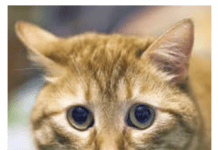Most communication between two people is verbal, but that between cat and cat and between cat and person involves several modes of contact. Some modes of feline communication may seem simpler than our own, but others, such as their sense of smell (olfaction), are more complex and, to us, more mysterious. Only some of what we think cats are communicating has been confirmed by research. What do we currently understand?
Expressing emotions
Cats communicate via displays of posture, facial expression, and wordless vocalizations. We understand that combinations of these signals express certain emotional states, says Katherine Houpt, VMD, veterinary behavior specialist at the Cornell University College of Veterinary Medicine.
Fright is one of these. A cat feeling fear flattens his ears against his head and dilates his pupils as if to take in all possible danger; he may hiss or spit if highly aroused. He crouches lower and lower as he grows more fearful, with all feet on the ground, prepared to flee. He faces his antagonist sideways with a watchful ear-dropped stare. His eyes may appear red, too, as his dilated pupils expose more retinal blood vessels to reflect light.
Offensive (pure) aggression that is unmotivated by fear is more subtle to our eyes, says Houpt, explaining that it shows in a postural display of straightened back with head dropped and legs extended to show his fullest height. Because a cats hind legs are longer than the forelegs, this gives his back a slant downward toward the front. His tail is pointing down, partially piloerected (hair puffed out) to add to his seemingly larger size.
Facial signs of aggression are subtler yet, with ears aimed to the side. The clearest facial sign is the pupil-constricted stare, as if to say the cat has homed in on his prey. Whiskers are moved forward, too.
The frightened cat that is pushed into defensive aggression by a threat coming too close may take the dramatic Halloween cat silhouette pose. With flattened ears and partially dilated pupils, he raises his piloerected tail up high and arches his back, bringing his feet near one another. It is a display shown sideways to the target of aggression, since this is how a cat shows his greatest size in order to intimidate. Other mixtures and levels of aggression and fear yield variations of crouching, arching, pupil dilation or constriction, and ear position.
In other situations, tail postures express moods. A cat crouched while stalking may wag the tip of her tail. A happily relaxed, standing cat will hold his tail down at a slight angle and pivot his ears forward. When in a greeting or welcoming mood, an upright cat will raise his tail vertically.
The importance of scent
Houpt says that olfaction is central to cat communication. Friendly face and body rubbing leave a personal scent from glands on the cheeks and around the base of the tail. Identification of known friends via smell is critical; a cat that has gained foreign smells from a veterinary hospital, for example, may be attacked by the friend that fails to recognize him. Tomcats and females in heat spray urine on prominent objects. They do so to mark their personal territory. Since the signal portion of the scent fades within a day, they may also scratch the object to indicate they have passed by on their daily rounds of their territory. Spraying can be instigated by the presence of someone new in the household (the equivalent of a new, competing toms presence outdoors), a new home, or a change in routine.
Uncovered feces can serve a similar purpose since it will carry anal sac secretions. Remarkably, Houpt estimates that smells are more important in feline communication than in canine.
Vocalization
As anyone with a highly vocal cat can attest, cat sounds communicate too. Among understood catcalls is the meow that accompanies a demand. The growl is, of course, a sign of displeasure in antagonistic situations. The more melodious and brief meows or murmurs intone comfortable moods, with brief, single tone chirps or murmurs indicating a greeting or request. The louder, more sustained and raspy calls are signs of distress (someone stepped on my tail!) or serious aggression.
The purrs meaning and source have been debated for decades. It is now known that purrs come from vibrations of the entire respiratory tract, primarily driven by the larynx.
Purrs do, as we imagine, most often express pleasure, but may also occur when cats are sick or even during the terminal stages of illness.



